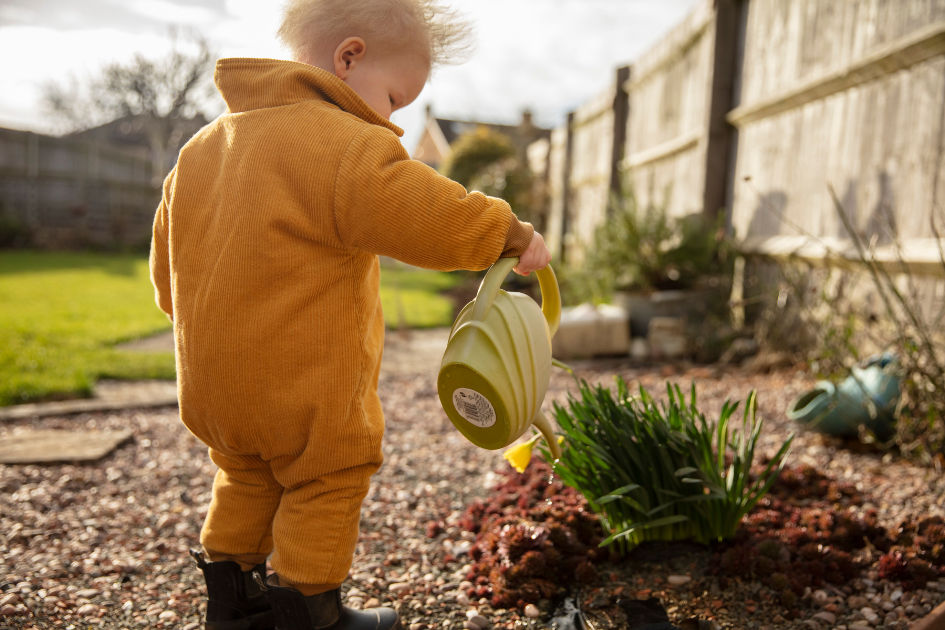Grow, Play, Learn: Celebrating Children’s Gardening Week with Agata Hendersen

This week marks Children’s Gardening Week, a time to dig into the fun, creativity, and lifelong benefits of gardening with little ones. To help parents and caregivers get started, we spoke to Agata Hendersen, a local garden designer and the creative mind behind Agata Hendersen Garden Design, who shared her advice on nurturing both plants and young imaginations.
"Interaction with nature teaches our kids to connect with the world around them and sparks curiosity about the environment. Gardening is fun and has enormous mental health benefits for grown-ups and children alike," says Agata.
Easy Plants for Little Green Fingers
Agata urges parents to avoid over-complicated, Pinterest-inspired schemes—like toilet roll planters or vertical pallets—that often lead to frustration.
“When introducing children to gardening, it’s key to start with forgiving and fun plants that are likely to thrive,” she explains. Here are her top picks for small spaces or pots:
- Cress - Simply sprinkle seeds on damp paper towel and watch them grow within days. A great windowsill project.
- Radishes - Quick-growing and satisfying for short attention spans.
- Cherry Tomatoes - Perfect in pots and a tasty snack straight off the vine.
- Strawberries - Great in containers or hanging baskets. Buy plug plants for best results.
- Wild Strawberries - These tiny berries grow well from seed and need less care.
- Herbs - Mint, parsley, dill and chives are low-maintenance and practically fool-proof.
- Sunflowers - Big, bold, and beautiful. Just be cautious when transplanting - young stems can be fragile.
Giving children the chance to choose what they grow helps them feel ownership and keeps their interest alive through the seasons.
Making Gardens Wildlife-Friendly (and Child-Safe)
Bringing wildlife into your garden turns it into a living classroom, says Agata. Kids can count butterflies, identify bees and learn how different species support the environment.
- Plant pollinator-friendly flowers like lavender, daisies, salvias and cosmos. For night-time pollinators, consider night-scented stocks or nicotiana - your evenings will smell divine!
- Install a bird feeder or bird bath - just keep feeders away from seating areas and ensure bird baths are shallow (no deeper than 3 cm) for safety.
- Build a bug hotel using sticks, pinecones, and hollow stems to attract ladybirds and solitary bees.
- Avoid chemicals - ditch pesticides and herbicides to keep your garden safe for kids and visiting creatures alike.
Hands-On Garden Activities for Kids
Gardening is more than just planting - it’s about play, creativity, and curiosity. Agata recommends a few engaging ways to keep little ones busy and learning:
- Seed Starting Station - Use yoghurt pots (not toilet rolls!) and pop them into a plastic bag to speed up germination.
- Nature Crafts - Collect leaves and flowers for pressing, printing or collage-making.
- Pick & Arrange - Let kids cut garden flowers and make their own mini arrangements.
- Garden-to-Table Cooking - Taste-test herbs, then use them in easy recipes together.
- Outdoor Reading Nook - Create a cosy corner with cushions for storytime surrounded by greenery.
Create a Garden They’ll Love to Be In
As kids get older, it can be harder to compete with screens and tech. Agata suggests transforming your outdoor space into somewhere children want to be - even if it’s not about gardening:
- Little ones will love a paddling pool, Wendy house, or chalk-art paving.
- Older children might appreciate a small climbing frame, sand and water play, or even a hanging pod chair to lounge in.
- Think of your garden as a multi-sensory escape that grows with your family.
Growing More Than Plants
"Bringing children into the garden is not only about growing plants - it’s about growing memories, curiosity, and care for the environment," says Agata. “It doesn’t need to be elaborate or expensive. A well-planned garden that suits your time, energy and love can transform your family’s life.”
Whether it’s the pride of harvesting a homegrown tomato or the joy of spotting a visiting butterfly, these small moments can inspire a lifetime of appreciation for the natural world.




